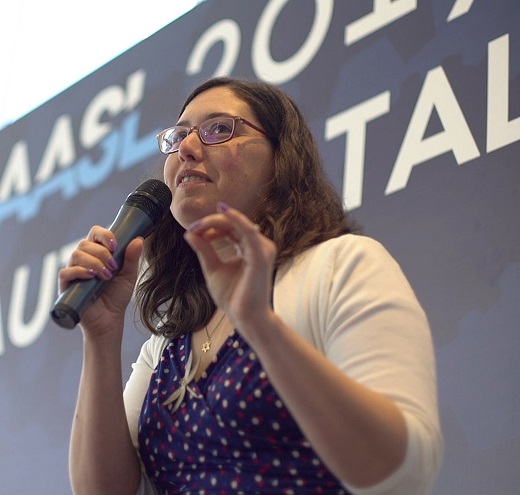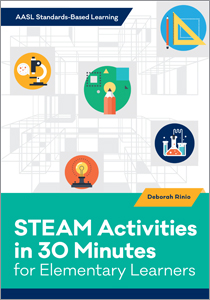Interview: Deborah Rinio on STEAM for elementary school learners
"As usual," said Deborah Rinio during our interview, "librarians continue to inquire, include, collaborate, curate, explore and engage no matter what the circumstances." She was referring to the unprecedented circumstances in which librarians, educators, and students are in—with schools closed amidst widespread lockdowns, distance learning has quickly transitioned from educational supplement to daily reality. Rinio's new book STEAM Activities in 30 Minutes for Elementary Learners, part of the AASL Standards–Based Learning Series, includes 14 scaffolded activities, many of which can be adapted for online teaching. In this interview we discuss her lifelong love of STEAM, how hands-on inquiry-based learning is still possible in online environments, and the innovative ways that school librarians and educators are finding to collaborate.
Congrats on the new book! What is it about STEAM learning that you find especially fascinating? Are you a lifelong math and science nerd?
I’ve always been interested in art and science. In both high school and college I participated in orchestra, band, and choir, while simultaneously taking biology, chemistry, and calculus. I participated in the science fair whenever possible, and naturally integrated music and art into my own learning. For example, my 9th grade science fair project was the distillation of essential oils by creating various scents from citrus fruits; a STEAM approach before I had ever heard STEAM used in this context! After moving to Fairbanks, Alaska I spent three years working for the  Geophysical Institute at the University of Alaska Fairbanks as a curriculum developer. I wrote hands-on lesson plans for Alaskan teachers to use with K-12 learners that focused on Alaskan science: tsunamis, climate change, and other geophysical phenomena. When I became a school librarian and started seeking collaborative opportunities with my educational colleagues, science was often the most natural fit. Science lends itself to inquiry and collaboration, and often leads to great service learning projects. We would investigate local ponds and plant life, research ways to be a more environmentally friendly school (such as recycling), and try our hand at coding and other technological pursuits.
Geophysical Institute at the University of Alaska Fairbanks as a curriculum developer. I wrote hands-on lesson plans for Alaskan teachers to use with K-12 learners that focused on Alaskan science: tsunamis, climate change, and other geophysical phenomena. When I became a school librarian and started seeking collaborative opportunities with my educational colleagues, science was often the most natural fit. Science lends itself to inquiry and collaboration, and often leads to great service learning projects. We would investigate local ponds and plant life, research ways to be a more environmentally friendly school (such as recycling), and try our hand at coding and other technological pursuits.
However, it wasn’t until I was at a conference and heard a presentation on STEAM after school programs in public libraries that I realized the STEAM approach in particular was doable not just in the science classroom or the public library, but in the elementary setting as well. Elementary school librarians often struggle with hands-on learning due to the limitations of their schedule. They see multiple classes of varying grade levels throughout the day, often with only a few minutes between each class. Repeatedly setting up and cleaning up for hands-on experiences can be difficult to accomplish with so little time. A conversation during the above mentioned conference presentation sparked the idea of scaffolding. Why couldn’t you do the same activity with all your learners with some small variations to make it more complex and developmentally appropriate as you move from Kindergarten to sixth grade? You can! Based on that idea, I took the hands-on lessons I had done with learners in the past or seen done by other educators and redesigned them to be scaffolded for the book.
In your recent Knowledge Quest blog post you called attention to the fact that according to AASL snapshot surveys, 52.97% of respondents are providing online classes during school closures. What are some ways that school librarians are adapting STEAM activities for online learning?
Conducting STEAM activities online takes a little bit of patience and ingenuity, but educators are proving that it is very doable. Although there are certainly STEAM activities that require equipment, space, or supplies that the average person doesn’t have at home, many of them (including all of the ones in the book) can be done with household items. Educators can guide their learners through STEAM activities in a few different ways. One option is to share directions with families and have them explore independently, taking photos or videos as they go. They can then share their observations with each other during a live event or using an asynchronous method like a Google Doc. Alternatively, the educator can set up their webcam so they can display the activity live for learners, pausing for questions, observations, and suggestions as they go.
For example, the “Working Together: Build-a-Tower Challenge” in my book involves learners first building a LEGO tower alone and then in a team. While learners can’t build together right now, they can still learn from each other. After each learner builds their own tower, they can share pictures / video of their tower and discuss what they did. What worked and what didn’t? Then, each learner can build a second tower, taking their own ideas and adding the ideas of others to make their tower stronger or taller. If learners don’t have LEGOs or other building-blocks available, perhaps they can use index cards or paper or another material. With older learners, they could work together to design an experiment to test the strength of different materials, conduct the experiment independently, and then share their results in a videoconference or Google doc, for example. With a little creativity, there is still room for hands-on inquiry-based learning online.
How do you think school closures and teaching remotely might spur innovation in how school librarians and educators collaborate?
Librarians have always been curators, pulling together the tools and resources educators and learners need to be successful. In the early days of Covid-19, educational companies were offering their services for free at an overwhelming rate. There was too much to sift through for most people! But librarians were in a perfect position to curate their resources and provide not only  master lists to teachers, but organize the information in a meaningful way to make it less overwhelming and more relevant to educators and families. This sets up librarians as the go-to experts for other educators to try new tools and/or enhance and innovate their lessons.
master lists to teachers, but organize the information in a meaningful way to make it less overwhelming and more relevant to educators and families. This sets up librarians as the go-to experts for other educators to try new tools and/or enhance and innovate their lessons.
As educators began to fall into a sort of routine, the opportunity for collaboration continued. I’ve seen librarians partner with teachers so that they tag on to the end of a teacher’s live session with students, providing a mini lesson or reading to students. I’ve seen librarians help other educators turn their lessons into online versions by providing their educational technology expertise. I’ve seen librarians become copyright and fair use experts, offering their guidance when it comes to what teachers can read to learners online and in what format; as well as accessibility champions, helping to ensure that as many learners as possible have access to library resources. School librarians are offering office hours in videoconference or chat for learners and educators so they can get help and ask questions, hosting twitter chats focusing on how to use the AASL Standards, and sharing their ideas with each other through online professional learning communities and blogs such as Knowledge Quest.
Learn more at the ALA Store.
